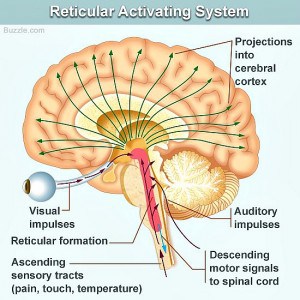
Importantly, the RAS is not involved in interpreting the quality or type of sensory input. Rather, it activates the entire cerebral cortex with energy, waking it up, increasing its level of arousal and readiness for interpretating incoming information and preparing the brain for appropriate action.
You will notice in the diagram on the right that specific sensory information comes into the RAS and the outflow goes to the entire cortex of the brain, waking it up and preparing it for the work is has to do.
The RAS is involved in almost everything we do.
All learning requires at least a minimal level of arousal in order to attend, concentrate, remember and put learning into memory storage.
The ability to regulate emotions, which often feed into behavioral issues, also depends upon sufficient levels of cortical arousal to inhibit impulses and to control strong emotions. Under-aroused children tend to be fussy, irritable, difficult to manage and are unavailable for learning.
Can iLs enhance the RAS?
The multi-sensory input of iLs has a profound effect on increasing activation of the RAS, thereby increasing the arousal of the entire brain to function optimally and effortlessly. A study by Dr. Sarah Schoen measuring the effect of iLs on arousal levels and auditory processing is currently submitted for publication and provides objective evidence to support what most iLs Associates are well aware of. That is, the iLs program produces positive results related to improved attention, stabilized levels of arousal and the ability to learn and retain information.
Dr. Sarah Schoen’s study on Arousal with the SPD Foundation used both behavioral measures and electrodermal skin response to measure arousal levels in children with Sensory Processing Disorder. Her study found that both under-responsive and over-responsive children achieved normal levels of arousal by the end of a 3-month iLs Program.



 © 2024 Unyte Health US Inc.
© 2024 Unyte Health US Inc.